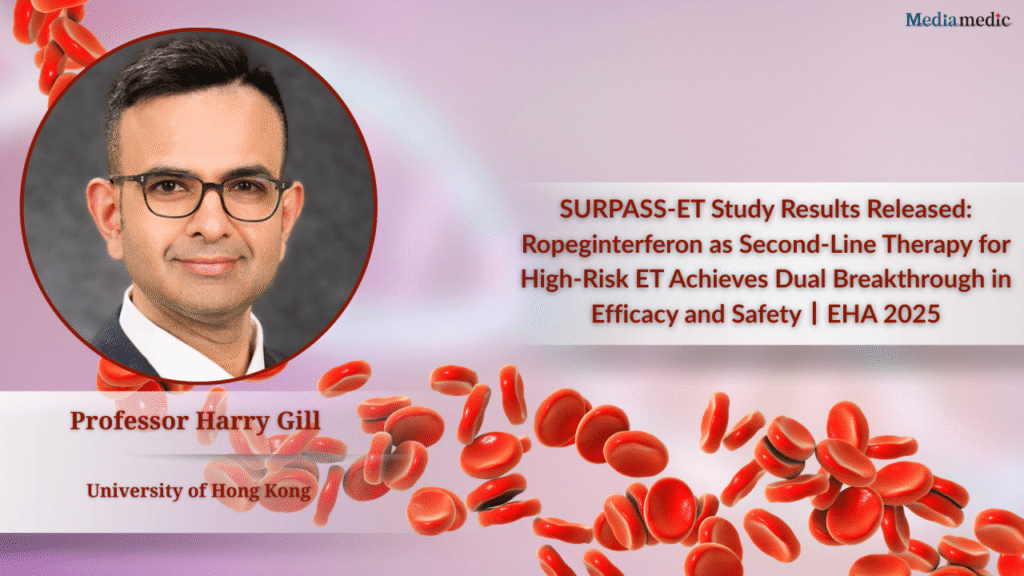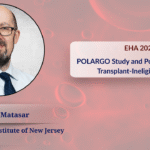
Editor's Note: At the recently held International Congress of Hematology, treatment advances in the field of Myeloproliferative Neoplasms (MPN) have garnered significant attention. As a classic subtype of MPN, Essential Thrombocythemia (ET) has seen no substantial breakthroughs in its treatment over the past two decades. In a Plenary Presentation, Professor Harry Gill of the University of Hong Kong's School of Clinical Medicine, on behalf of collaborators from 59 research centers worldwide, announced the top-line data from the Phase III SURPASS-ET clinical study. The study confirms that the novel long-acting interferon, Ropeginterferon alfa-2b (hereinafter referred to as Ropeginterferon), is comprehensively superior to the conventional drug anagrelide in both efficacy and safety as a second-line therapy, bringing new hope to patients with high-risk ET.Essential Thrombocythemia (ET) is a BCR-ABL-negative MPN characterized by excessive platelet production, typically associated with mutations in the JAK2, CALR, or MPL genes. The disease not only significantly increases the risk of thrombotic and hemorrhagic events but also carries the potential for transformation to myelofibrosis or even acute myeloid leukemia. Currently, first-line treatment primarily consists of cytoreductive therapies such as hydroxyurea. However, a portion of patients require better second-line options due to intolerance or resistance. Since the approval of anagrelide in the United States in 1997, the field of ET treatment has long lacked innovative drugs. Ropeginterferon, a novel mono-pegylated interferon, has already been approved in over 40 countries and regions for the treatment of Polycythemia Vera (PV), with its potent cytoreductive efficacy, favorable safety profile, and anti-clonal activity having been well-established. The SURPASS-ET study was designed to evaluate its potential in the treatment of ET.
SURPASS-ET Study Design: A Head-to-Head Validation of a New Second-Line Strategy
SURPASS-ET is a randomized, open-label, multicenter Phase III clinical trial designed to directly compare the efficacy and safety of Ropeginterferon versus anagrelide in high-risk ET patients. The study enrolled a total of 174 adult high-risk ET patients who were intolerant or resistant to hydroxyurea and had not previously received interferon-alfa therapy or tested negative for anti-Ropeginterferon antibodies.
Subjects were randomly assigned in a 1:1 ratio to either the Ropeginterferon group or the anagrelide group. Ropeginterferon group: Starting dose of 250 mcg, increased to 350 mcg in week 2, and stabilized at 500 mcg every two weeks from week 4 onwards. Anagrelide group: Dosed according to the standard label instructions to maintain ideal blood cell counts.
The primary endpoint of the study was the achievement of a clinico-hematologic response as defined by the modified European LeukemiaNet (ELN) criteria at months 9 and 12 of treatment. This composite endpoint required a platelet count below 400×10⁹/L, a white blood cell count below 9.5×10⁹/L, improvement in disease-related symptoms such as splenomegaly, and the absence of thrombo-hemorrhagic events. Key secondary endpoints included changes in JAK2/CALR mutant allele frequency (VAF), symptom improvement, incidence of thrombotic events, and safety.

Interpretation of Study Results: Ropeginterferon Demonstrates Comprehensive Superiority in Efficacy and Safety
The study results showed that SURPASS-ET successfully met its primary endpoint. At 12 months of treatment, the modified ELN response rate in the Ropeginterferon group was 42.9%, significantly superior to the 6% in the anagrelide group, with the difference being highly statistically significant.
In the individual components constituting the primary endpoint, Ropeginterferon also showed overwhelming advantages, including platelet control, white blood cell control, normalization of peripheral blood counts, improvement in spleen-related symptoms, improvement in overall symptom scores, and freedom from thrombotic events, all of which were significantly better than the anagrelide group. The curves tracking blood cell count changes showed that platelet and white blood cell levels in the Ropeginterferon group were controlled more rapidly and durably.
In terms of safety, Ropeginterferon’s performance was also more favorable. The proportion of patients experiencing thromboembolic and cardiovascular events in the Ropeginterferon group was only 1.1%, compared to 10% in the anagrelide group. Furthermore, the rate of discontinuation due to treatment-emergent adverse events (TEAEs) was only 5.5% in the Ropeginterferon group, far lower than the 20% in the anagrelide group. Three deaths occurred in the anagrelide group (due to acute myocardial infarction, pneumonia, and COVID-19, respectively), while no deaths were reported in the Ropeginterferon group.
Regarding common adverse events, the most frequent in the Ropeginterferon group was elevated transaminases, but the vast majority (approx. 99%) were grade 1-2 and clinically manageable. In contrast, patients in the anagrelide group more commonly experienced troublesome symptoms such as palpitations (32.5%) and headache (31.3%).

Molecular Response: Unveiling a Deeper Disease-Modifying Potential
As a key secondary endpoint, the study conducted an in-depth assessment of molecular response, further revealing the disease-modifying potential of Ropeginterferon. After 12 months of treatment, nearly 30% of patients in the Ropeginterferon group achieved a partial molecular response, with 2.8% of patients even achieving a Complete Molecular Response (CMR). Notably, no molecular response was observed in the anagrelide group.
Ropeginterferon significantly reduced the allele frequency of both JAK2 V617F and CALR mutations. Professor Gill specifically pointed out, “We observed two CALR-mutated patients who achieved a complete molecular response after using Ropeginterferon, which is very encouraging.” This finding provides strong evidence that Ropeginterferon can not only control blood cell counts but also fundamentally target and clear the malignant clone, possessing the potential to alter the natural course of the disease.

Expert Q&A and Clinical Implications
In the subsequent Q&A session, Professor Gill addressed key questions relevant to clinical practice.
On the definition of hydroxyurea intolerance/resistance: Professor Gill clarified that the study adopted the standard ELN definition, and the proportions of intolerance and resistance in the population were roughly balanced. He added that in Asian populations, it has been observed that patients may experience symptoms of intolerance before reaching the high doses commonly used in Western patients (e.g., 2-3 grams daily), which may be related to ethnic differences.
On the detection of complete molecular response: The study utilized Next-Generation Sequencing (NGS) with a sensitivity of 10⁻⁴ to 10⁻⁵, but digital PCR was not routinely used for confirmation.
On patient tolerability: In the study, the median dose of Ropeginterferon was approximately 480 mcg every two weeks, close to the planned dose of 500 mcg, demonstrating good tolerability. For patients with a poor initial response, continuing the 500 mcg dose could still lead to a “late response” in some patients, achieving normalization of blood counts after 12 months.
In summary, the top-line results of the SURPASS-ET study clearly indicate that Ropeginterferon, as a second-line therapy for high-risk ET patients who are intolerant or resistant to hydroxyurea, is significantly superior to anagrelide in both efficacy and safety. This achievement not only provides a powerful new treatment option for high-risk ET patients but also, with its demonstrated disease-modifying potential, particularly the deep molecular responses, signals a new era in ET treatment—moving from mere symptom control towards the pursuit of clonal eradication and a potential cure. The success of this study is undoubtedly a major step forward in the field of MPN therapy, bringing new dawn for improving the prognosis of ET patients worldwide.


